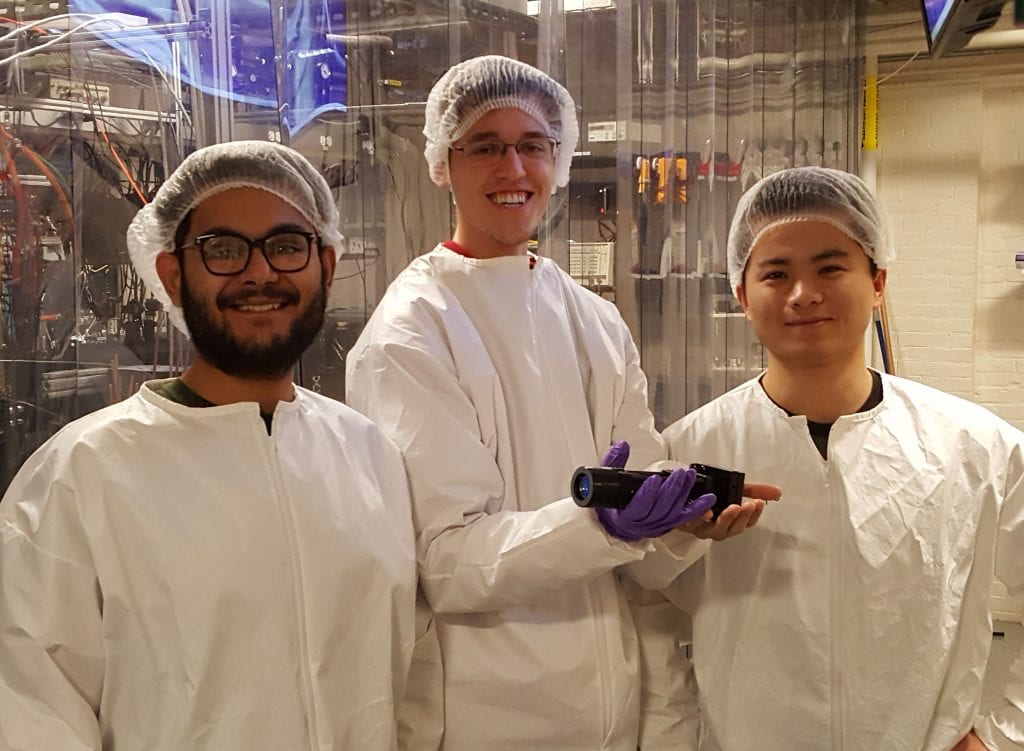Today we created a ring shaped fermionic quantum gas for the first time.
After some tuning up, we’ll begin studies of persistent flow in fermionic superfluids.
With the “Feshbach” magnetic coils now working, we can control the interactions between lithium atoms when they are trapped in the glass “science” cell, and we have observed evaporative cooling of atoms in that trap. The density and temperature already look favorable enough to add in the beam that will shape the ultracold Fermi gas into a ring shape. One big step closer to our experimental goals.
For over a year now we (mostly Dan) have been designing, constructing, and testing a matched pair of objectives for projecting dipole trapping beams and imaging the atoms in the glass cell part of the vacuum chamber. The cell windows have a nanopatterned anti-reflection coating that we really want to keep clean, so today the team donned bunny suits to reduce dust during the brief time during the installation that the cell windows won’t be fully covered/enclosed. Assuming we get as close to the 1.5 micron resolution limit as we did during bench testing, we’ll be in great shape for upcoming experiments.
It was quite a surprise to me, but probably shouldn’t have been. This year’s Nobel prize was awarded for breakthroughs that have been directly important in most of the work I’ve done myself. The common thread between both parts of the prize is laser control of matter: forces exerted by light (Ashkin), and rapid delivery of laser energy (Mourou and Strickland). Ashkin’s work is remarkable partly because the force light exerts is so small it usually not noticeable. Experiments at Dartmouth in 1903 proved light does exert a force, in agreement with electromagnetic theory, but it took 85 years and the invention of the laser before anyone demonstrated that those forces could be useful. Now, the world’s most accurate clocks are built using atoms cooled almost to absolute zero temperature, and held in place by a focused laser beam.
The impact of Mourou and Strickland’s chirped pulse amplification is at an opposite physical extreme. Their original motivation was to create a better tool for studies of ionization processes, but they were so wildly successful the technique was adopted for many other applications. The laser pulses they created were intense enough to vaporize any material, and fast enough that they could blast the material away before the surrounding area even had time to be affected. This revolutionary capability is now routinely used for surgeries on delicate tissues like the eyes. Ultrafast lasers can also cut through high explosives without detonating them, which is important for decommissioning aging stockpiles of nuclear weapons. Super-sized versions of these lasers are even being used to try to achieve fusion in laser-driven plasma experiments.
I worked with ultrafast lasers using chirped-pulse amplification as an undergraduate and during my own time as a graduate student at the University of Rochester where Mourou and Strickland developed the technique (15 years earlier…) I never overlapped with either of them there, but certainly was aware of their work and heard it talked about. From my postdoctoral work on most everything I have done has relied heavily on “optical tweezers” for controlling the position and momentum of ultracold quantum gases, so it’s fair to say I’ve been a happy direct beneficiary of Art Ashkin’s legacy as well.